 полная версия
полная версияThe Indian To-day
He carried his point to some extent, and himself saved Captain Stewart, his friend, by giving up all of his property to ransom him. In difficulties between the races since colonial times there has been an unbroken record of heroic work in the rescue of missionaries and other white persons resident among the Indians by their native converts and friends. In the Minnesota Sioux outbreak of 1862 there were many notable instances. A man named Arrow stood beside Mr. Spencer and dared the infuriated warriors to touch him. There were over two hundred white captives saved by friendly Indians and delivered to General Sibley at Camp Release. During the following December some young Yanktonnais Sioux voluntarily ransomed and delivered up two white women and four children. I knew some of these men well; among them Fast Walking, who carried one of the children on his back to safety, after giving his own horse to redeem him. Seldom have such deeds been rewarded or even appreciated. When these men became old and feeble an attempt was made to have them recompensed by Congressional appropriation, but so far as I am informed it has been unsuccessful.
I do not wish to disparage any one, but I do say that the virtues claimed by "Christian civilization" are not peculiar to any culture or religion. My people were very simple and unpractical – the modern obstacle to the fulfilment of the Christ ideal. Their strength lay in self-denial. Not only men, but women of the race have served the nation at most opportune moments in the history of this country.
HISTORIC INDIAN WOMENIt is remembered that Pocahontas saved the first Virginia colony from utter destruction because of her love for Captain John Smith, who was the heart and brain of the colony. It was the women of the Oneida and Stockbridge Indians who advised their men not to join King Philip against the New England colonies, and, later, pointed out the wisdom of maintaining neutrality during the war of the Revolution.
Perhaps no greater service has been rendered by any Indian girl to the white race than by Catherine, the Ojibway maid, at the height of Pontiac's great conspiracy. Had it not been for her timely warning of her lover, Captain Gladwyn, Fort Detroit would have met the same fate as the other forts, and the large number of Indians who held the siege for three months would have scattered to wipe out the border settlements of Ohio and Pennsylvania. The success of Pontiac would certainly have delayed the settlement of the Ohio valley for many years. It is not to be supposed that Catherine was moved to give her warning by anything save her true womanly instincts. She stood between two races, and in her love and bravery cut short a struggle that might have proved too full of caprice and cruelty on both sides. She was civilization's angel, and should have a niche in history beside Pocahontas.
Sacajawea, the young Indian mother who guided Lewis and Clark in their glorious expedition to the Pacific, was another brave woman. It is true that she was living in captivity, but according to Indian usage that would not affect her social position. It does not appear that she joined the expedition in order to regain her tribe, but rather from a sense of duty and purpose of high usefulness. Not only as guide, but as interpreter, and in rescuing the records of the expedition when their canoe was overturned in the Missouri River, the "Bird Woman" was of invaluable aid, and is a true heroine of the annals of exploration.
THE CHILDREN'S HERONearly all the early explorers owed much to the natives. Who told the white men of the wonders of the Yellowstone Park and the canyon of the Colorado? Who guided them and served them without expectation of credit or honor? It is a principle among us to serve friend or guest to the utmost, and in the old days it was considered ill-bred to ask for any remuneration. To-day we have a new race, the motive of whose actions is the same as that of a civilized man. Nothing is given unless an equivalent is returned, or even a little more if he can secure it. Yet the inherent racial traits are there: latent, no doubt, but still there. The red man still retains his love of service; his love for his country. Once he has pledged his word to defend the American flag, he stands by it manfully.
In the Civil War many Indians fought on both sides, some of them as officers. General Grant had a full-blood Indian on his staff: Col. Ely Parker, afterward Commissioner of Indian Affairs. At one time in recent years a company of Indians was recruited in the regular army, and individual red men are still rendering good service in both army and navy (thirty-five ex-students of Carlisle alone), as well as in other branches of the Federal service. We have lived to see men of our blood in the councils of the nation, and an Indian Register of the Treasury, who must sign all our currency before it is valid. An Indian head is on the five-dollar bill and the new nickel.
George Guess, or Sequoyah, the inventor of the Cherokee alphabet, is the only red man admitted to the nation's Hall of Fame in the Capitol at Washington. The Indian languages, more than fifty in number, are better appreciated and more studied to-day than ever before. Half our states have Indian names, and more than that proportion of our principal lakes and rivers. These names are as richly sonorous as they are packed with significance, and our grandchildren will regret it if we suffer the tongues that gave them birth to die out and be forgotten.
Best of all, perhaps, we are beginning to recognize the Indian's good sense and sanity in the way of simple living and the mastery of the great out of doors. Like him, the wisest Americans are living, playing, and sleeping in the open for at least a part of the year, receiving the vital benefits of the pure air and sunlight. His deeds are carved upon the very rocks; the names he loved to speak are fastened upon the landscape; and he still lives in spirit, silently leading the multitude, for the new generation have taken him for their hero and model.
I call upon the parents of America to give their fullest support to those great organizations, the Boy Scouts and the Camp Fire Girls. The young people of to-day are learning through this movement much of the wisdom of the first American. In the mad rush for wealth we have too long overlooked the foundations of our national welfare. The contribution of the American Indian, though considerable from any point of view, is not to be measured by material acquirement. Its greatest worth is spiritual and philosophical. He will live, not only in the splendor of his past, the poetry of his legends and his art, not only in the interfusion of his blood with yours, and his faithful adherence to the new ideals of American citizenship, but in, the living thought of the nation.
THE ENDBIBLIOGRAPHY
The documents chiefly used in the preparation of this book, aside from the author's own observations and personal knowledge, were the annual reports of the United States Commissioner of Indian Affairs, of the United States Board of Indian Commissioners, and of the Bureau of American Ethnology, the proceedings of the Mohonk Indian Conferences, and of religious and philanthropic societies engaged in Indian work; also the reports and magazines published by the larger Indian schools, especially Carlisle and Hampton. The following list of books about the North American Indian is not presented as complete in any sense, but merely as a suggestive guide to the reader who wishes to pursue the subject further:
EARLY STUDENTS AND EXPLORERS
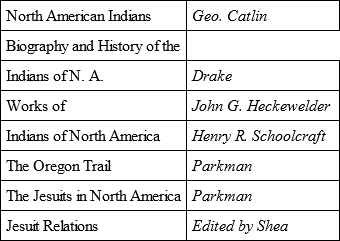
INDIAN MISSIONS

LEGENDS AND FOLKLORE
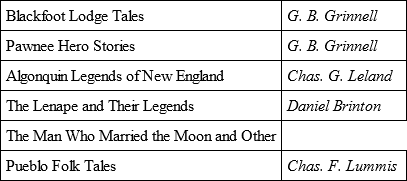
MUSIC AND ART
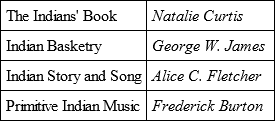
MODERN WRITERS
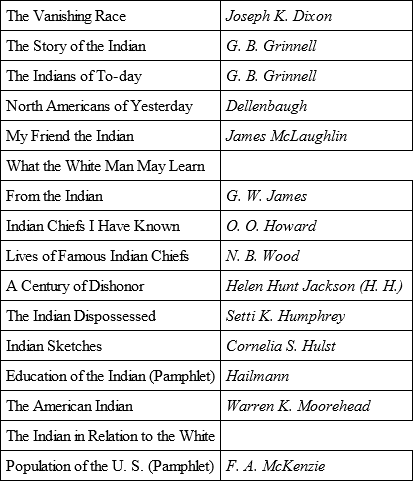
FICTION
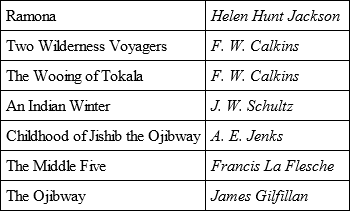
TABLE OF INDIAN RESERVATIONSIN THE UNITED STATES
(Compiled by the Office of Indian Affairs.)Arizona
Camp McDowell
Colorado River
Fort Apache
Gila Bend
Gila River
Havasupai
Hopi
Navajo
Papago
Salt River
San Carlos
Walapai
California
Digger
Hupa Valley
Mission (28 reserves)
Round Valley
Tule River
Yuma
Colorado
Ute
Idaho
Coeur d'Alene
Fort Hall
Lapwai
Lemhi
Iowa
Sauk and Fox
Kansas
Chippewa and Munsee
Iowa
Kickapoo
Potawatomie
Sauk and Fox
Michigan
Isabella
L'Anse
Ontonagon
Minnesota
Bois Fort
Deer Creek
Fond du Lac
Grand Portage
Leech Lake
Mdewakanton
Mille Lac
Red Lake
Vermillion Lake
White Earth
White Oak Point and Chippewa
Montana
Blackfeet
Crow
Fort Belknap
Fort Peck
Jocko
Northern Cheyenne
Nebraska
Niobrara
Omaha
Ponca
Sioux (additional)
Winnebago
Nevada
Duck Valley
Moapa River
Pyramid Lake
Walker River
New Mexico
Jicarilla Apache
Mescalero Apache
Pueblos (20 reserves)
New York
Allegany
Cattaraugus
Oil Spring
Oneida
Onondaga
St. Regis
Tonawanda
Tuscarora
North Carolina
Qualla Boundary (Cherokee)
North Dakota
Devil's Lake
Fort Berthold
Standing Rock
Turtle Mountain
Oklahoma
Cherokee
Cheyenne and Arapahoe
Chickasaw
Chocktaw
Creek
Iowa
Kansa or Kaw
Kickapoo
Kiowa and Comanche
Modoc
Oakland
Osage
Otoe
Ottawa
Pawnee
Peoria
Ponca
Potawatomie
Quapaw
Sauk and Fox
Seminole
Seneca
Shawnee
Wichita
Wyandot
Oregon
Grande Ronde
Klamath
Siletz
Umatilla
Warm Springs
South Dakota
Crow Creek and Old Winnebago
Lake Traverse
Cheyenne River
Lower Brule
Pine Ridge
Rosebud
Yankton
Utah
Uintah Valley
Uncompahgre
Washington
Chehalis
Columbia
Colville
Hoh River
Lummi
Makah
Muckleshoot
Nisqually
Ozette
Fort Madison
Puyallup
Quileute
Quinaiette
Shoalwater
Skokomish
Snohomish or Tulalip
Spokan
Squaxon Island
Swinomish
Yakima
Wisconsin
Lac Court Oreille
Lac du Flambeau
La Pointe
Red Cliff
Menominee
Oneida
Stockbridge
Wyoming
Wind River




